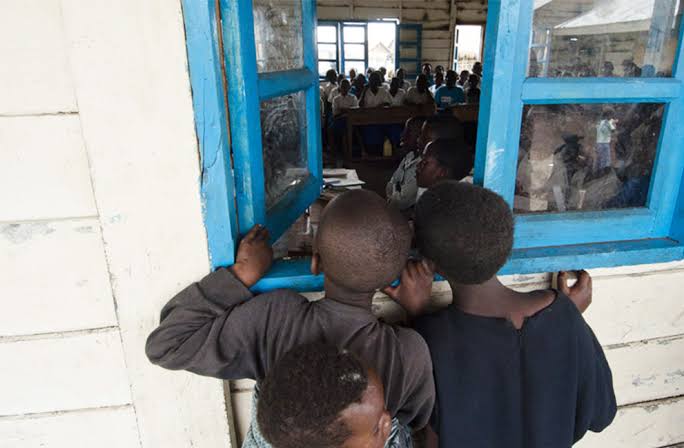Nation
UNESCO faults FG on out of school children

Adebayo Obajemu
Figures have a way of breeding tensions, and out of the blues such tensions will begin to smoulder, that’s exactly what is going on between the Nigerian government and a United Nations agency, United Nations Educational, Scientific and Cultural Organisation, UNESCO, over the exact figure of out-of-school children in the country.
This is not the first time such argument over numbers would surface. Early in May this year, the Director of Press and Public Relations in the Federal Ministry of Education, Ben Bem Goong, stated that the number of out-of-school children of 13.5 million in the 2018 National Personnel Audit by UBEC was not valid.
The 2018 National Personnel Audit had the most recent information on out-of-school children in Nigeria. It is pathetic that the number of out-of-school children in Nigeria has risen to 20 million despite the government’s decision to spend N1bn ($2.3m) on feeding school pupils on a daily basis.
But government officials had given different figures, which have confused analysts. Goong claimed there were only 6.9 million out-of-school children in the country as of 2020, not 18.5 million as stated in the National Personnel Audit report.
He also quoted copiously from page 11 of a booklet containing the 2020 Annual Ministerial Press Briefing by the Minister of Education Adamu Adamu, stating, “We have reduced the figure of out-of-school children from 10.1 million in 2019 to 6.9 million in 2020.”
Gong had stated that the Federal Government has a reliable template which it uses to determine the number of children born in Nigeria per time, and the number of out-of-school children, maintaining that the figure is not as high as UNESCO had claimed.
“We use a reliable template with National Population Commission (NPopC) to calculate this in order to arrive at a reliable and acceptable figure. What we do is that we harvest the birth rate from NPopC which has figure of numbers of children born in Nigeria every year. We also do our routine school census which tells us how many are in school.
“When we minus the figure from the birth rate and the number of children that are in school using the outcome of our school census, then we arrive at a particular figure which can assume that are not in school. We have all these information and we conduct school census, then return to the NPopC and work on this template.
“So where UNESCO got its figures and methods used to collate such data and arrived at over 20 million out-of-school children is what I don’t know and can’t explain. So, we absolutely reject the figure as relates to number out-of-school children in Nigeria.
Gong says many students are attending unconventional schools, especially in the north, but are not captured in the survey.
The official adds that billions of dollars have been invested in education by the Nigerian government and the World Bank. He, therefore, wonders how UNESCO could be right.
“Apart from the school feeding programme, we also have the Better Education Service Delivery for All programme. It is a World Bank programme and Nigeria was given a grant of $500m, [which] was deployed in 17 out of the 36 states,” Gong says.
The spokesman added that a census that the government organised showed that school enrollment had increased.
“I really don’t know where UNESCO is getting its figures. You need to ask. Nigeria’s population is about 200 million. How many children are in school? How can they say 20 million children are out of school?” Gong says.
UNICEF had warned that the rising insecurity in the country, especially in the northwest where thousands of schools were forced to shut down, could lead to an increase in the number of out-of-school children.
But in a further confirmation of UBEC report, The United Nations UNESCO, in its latest global data, said Nigeria now has about 20 million out-of-school children.
The UNESCO figure is three times the figure (6.9 million) which the Nigerian government claimed as the number of out-of-school children in the country as of May this year.
According to the global body, there were 244 million children and youth between the ages of six and 18 worldwide who were still out of school. UNESCO stated that India, Nigeria and Pakistan have the highest figures for out-of-school children globally.
Before insecurity escalated to unprecedented heights, in the last one and half year, the figure in Nigeria was between 10.5 and 13.5 million. But with insecurity and kidnapping of school children, most parents have withdrawn their children and wards from schools.
Recall that early in the year, Senate President, Senator Ahmad Lawan, had raised concerns about the spiralling numbers of out-of-school children, especially the Almajiris in the north.
In a recent discussions in a motion on the need to integrate Almajiri education into the modern system of education in Nigeria, relating to the deplorable condition and plight of the Almajiris in the north, Lawan said that the problem was not only at a social level but also a security challenge.
On its own, UNESCO disclosed the figures in a statement that reads: “The new estimates, published online by the UNESCO Institute for Statistics (UIS) and Global Education Monitoring (GEM) Report, showed that sub-Saharan Africa remains the region with the most children and youths out of school. It is also the only region where this number is increasing; out-of-school rates are falling more slowly than the rate at which the school-age population is growing.
“The region with the second highest out-of-school population is Central and Southern Asia with 85 million. The top three countries with the most children and youth excluded from education are: India, Nigeria and Pakistan.
“Important data gaps have been filled in countries that have large out-of-school numbers but where no administrative data of good quality has been available for over a decade, such as Nigeria, which has an estimated 20.2 million children and youth out of school, Ethiopia (10.5 million), the Democratic Republic of Congo (5.9 million) and Kenya (1.8 million),” UNESCO noted.
UNESCO released the data sequel to the resumption of pupils in schools for a new session this month in most countries. The organisation expressed worry about the number of out-of-school children and its impacts on achieving the Sustainable Development Goals, among which is Goal Four – quality education for all by 2030.
As it is, many pupils may not return to school as no fewer than 650 schools have remained shut in some troubled states owing to attacks by terrorists in different parts of the country. Many northern states have come under assault by terrorists, bandits and kidnappers with many people, including children, killed and several others kidnapped. The most hit states are Kaduna, Zamfara, Katsina and Niger; while Sokoto, Kebbi, Bauchi, Plateau and Taraba states have not been spared by the attackers.
Ten states are at the top of the chart regarding Nigeria’s about 20 million out-of-school children. Kano State had the most while Akwa-Ibom, Katsina and Kaduna followed closely. Other states that ranked high on the list are Taraba, Sokoto, Yobe, Zamfara and Bauchi. The states with the lowest numbers of out-of-school children were Cross River, Abia, Kwara, Enugu, Bayelsa, Ekiti and FCT.
Professor Abdullahi Abubakar, an educationalist told Business Hallmark that “Unless the federal government up its tempo in the area of security, the UNESCO figure will further rise by the beginning of next year. Bandits and terrorists are consolidating in many areas of the north, and in those areas, you know what it means closure of schools.





